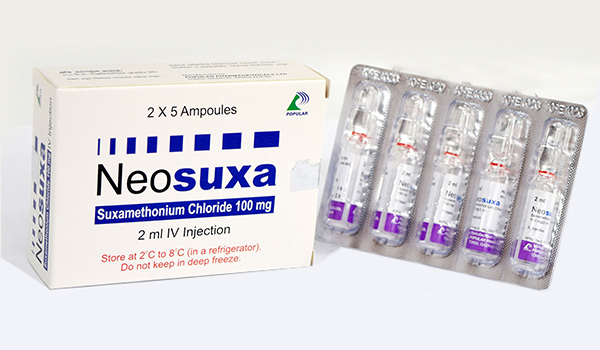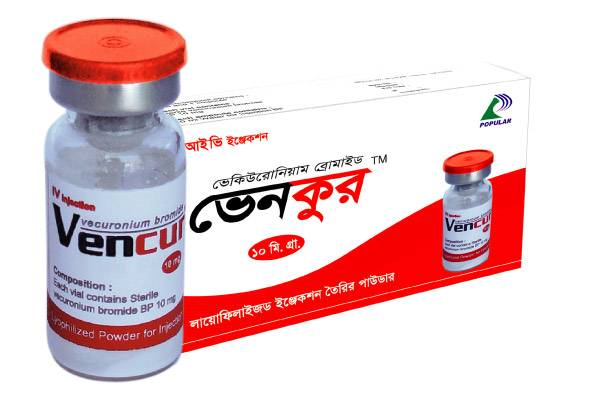Indication
For the production of skeletal muscle relaxation in anesthesia. Suited for procedures requiring only brief relaxation such as endotracheal intubation, endoscopic examinations, orthopaedic manipulations, short surgical procedures and electro-convulsive therapy.
Dosage & Administration
Dosage is individualised and its administration should be determined after careful assessment of the patient. The dose of Suxamethonium is dependent on bodyweight, the degree of muscle relaxation required and the response of individual patients. Suxamethonium causes paralysis of the respiratory muscles, therefore after administration, respiration must be controlled. It should not be administered to a conscious patient. An initial test dose of 0.1 mg/kg may be given intravenously to determine the patient's response. Adult: For short procedures, such as endotracheal intubation the usual adult dose is 0.6 mg/kg (range 0.3-1.1 mg/kg) adminstered IV over 10 to 30 seconds. This dose produces muscle relaxation in about 60 seconds and has a duration of approximately 4 to 6 minutes. Larger doses produce more prolonged muscle relaxation. For more prolonged surgical procedures in an adult, Suxamethonium is commonly given by IV infusion at a rate of 2.5-4.3
mg/minute. When given by intravenous infusion Suxamethonium should be diluted to 0.1 to 0.2% (1-2 mg/mL) in 5% dextrose solution or sterile isotonic saline. Children: Neonates and premature infants may be relatively resistant to Suxamethonium . The usual paediatric IV dose is 1 to 2 mg/kg. If necessary, additional doses may be administered in accordance with patient's response. Continuous IV infusions of Suxamethonium are considered unsafe in neonates and children because of the risk of inducing malignant hyperthermia. IV bolus in
children may result in profound bradycardia or on occasion asystole. This tends to be more common after a second dose. Pre-treatment with atropine can reduce the risk of bradycardia. When a suitable vein is inaccessible, Suxamethonium may occasionally be given by intramuscular injection. A suggested IM dose for adults and children may be up to 2.5 mg/kg but the total dose should not exceed 150 mg. Diluted solutions of Suxamethonium must be used within 24 hours of preparation. Discard unused solutions.
Precautions
Suxamethonium should only be administered under strict supervision of an anaesthetist familiar with its actions, characteristics and hazards who is skilled in the management of artifical respiration and only when facilities are instantly available for endotracheal intubation and for providing adequate ventilation of the patient, including the administration of oxygen under positive pressure. Be prepared to assist or control respiration. Suxamethonium has no effect on consciousness, pain threshold or cerebration. It should therefore only be used
with adequate anaesthesia.
Use in Pregnancy: Category A. Safety of the use of Suxamethonium in pregnancy has not been established with respect to effects on foetal development. Therefore Suxamethonium should not be administered to pregnant women unless the potential benefit outweighs the possible hazards. Plasma pseudocholinesterase levels are decreased in pregnancy and several days postpartum by approximately 25%, therfore a high proportion of these patients may be expected to show prolonged apnoea.
Use in Lactation: It is not known whether Suxamethonium chloride is distributed into breast milk.



